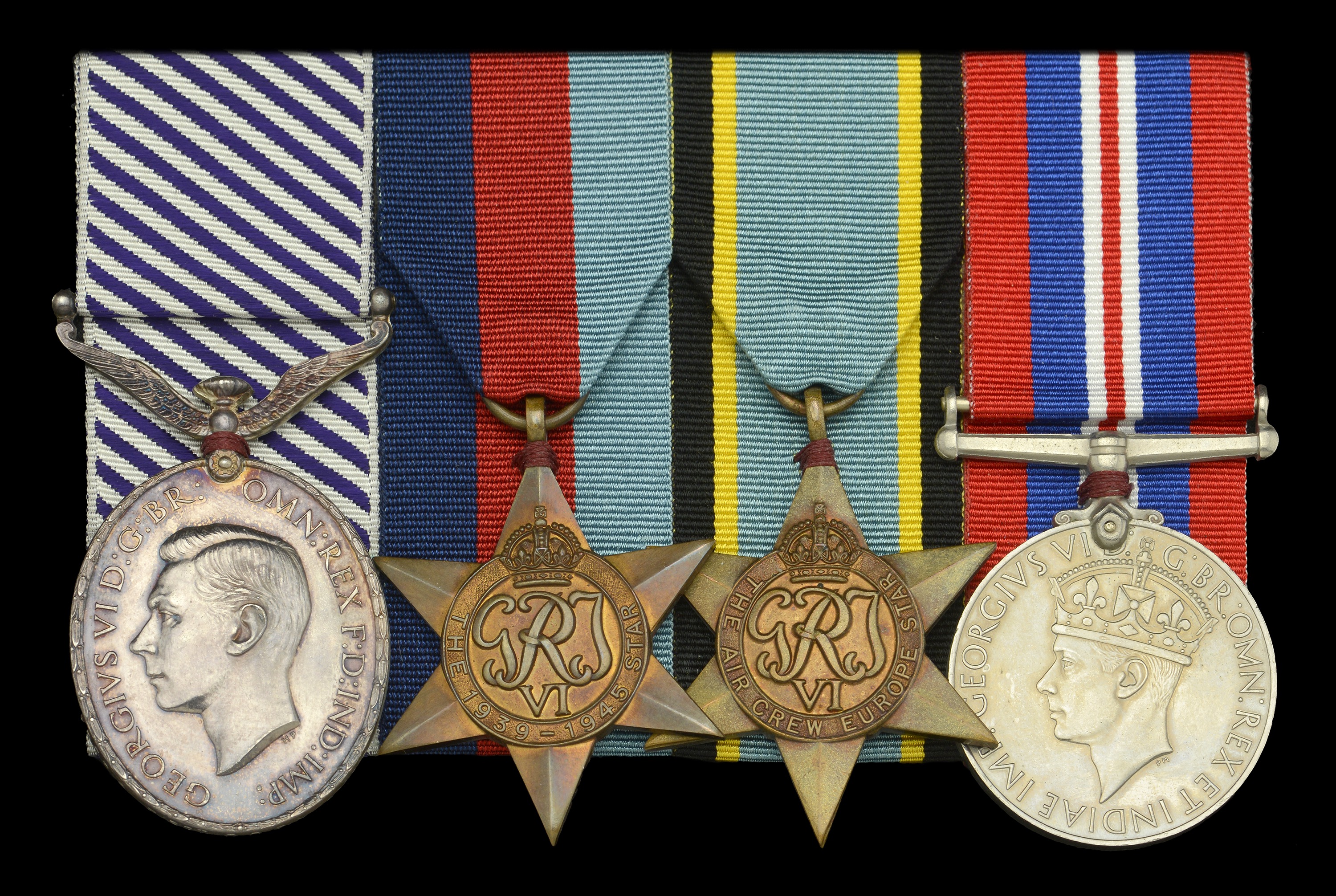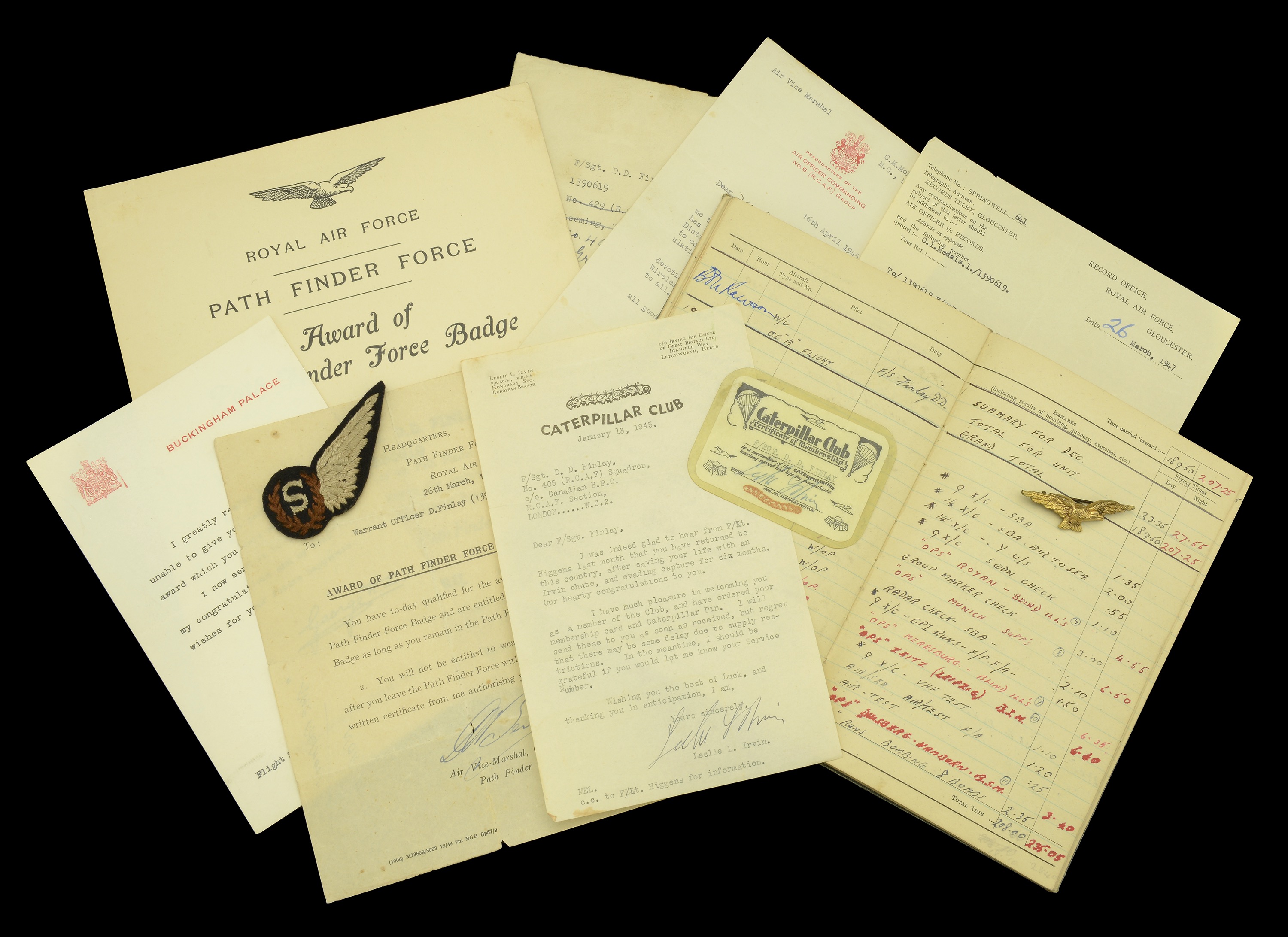A Second War ‘Evader’s’ D.F.M. group of four awarded to Flight Sergeant D. D. Finlay, Royal Canadian Air Force, who was shot down during the Nuremberg Raid, 30 March 1944; after six months on the run, he made it home, and completed his tour with the Path Finder Force Distinguished Flying Medal, G.VI.R. (1390619 F/Sgt. D. D. Finlay, R.A.F.); 1939-45 Star; Air Crew Europe Star; War Medal 1939-45, mounted court-style for wear, extremely fine (4) £2,800-£3,400 --- Importation Duty This lot is subject to importation duty of 5% on the hammer price unless exported outside the UK --- --- Provenance: Dix Noonan Webb, October 1997. D.F.M. London Gazette 23 March 1945. The original Recommendation states: ‘Flight Sergeant Donald David Finlay, 429 (R.C.A.F.) Squadron, has participated in sixteen attacks on enemy territory, including two attacks on Berlin and attacks on Frankfurt, Leipzig and the Ruhr. He has at all times proved himself to be a conscientious and valuable member of his crew, never lacking in courage, fortitude and cheerfulness. During his sixteenth sortie which was against Nuremberg on the 30th of March, 1944, his aircraft was shot down over enemy territory, but Flight Sergeant Finlay evaded capture and on his return to this country six months later requested to be sent back to his old squadron to finish his tour of duty.’ Donald Finlay enlisted in the Royal Canadian Air Force and first attended 7 Air Gunnery Course, 3 Air Gunnery School, during March and April 1943, before proceeding to 1664 Conversion Unit in August and September of that year, and whilst with this unit flew his first operational sortie, leaflet dropping over Paris as part of Operation Nickel on 23 July 1943. He received his first operational posting to 429 Squadron on 26 September 1943, and as a Wireless Operator in Halifaxes flew his first bombing raid, to Hanover, on 27 Septemebr 1943; furhter targets over the next six months included Kassel, Dusseldorf, Frankfurt, Leipzig, Stuttgart, and Berlin. On his sixteenth sortie with 429 Squadron, against Nuremberg on the night of 30 March 1944, Bomber Command’s most deadly night of the War, he was shot down and baled out 10 km south east of Flaxweiler. At the village of Stuppich he was taken in by a family who later moved him to Altlinster, where he remained hidden in a stable until the 14th September. After a visit to the American Embassy in Luxembourg where he obtained the necessary travel permit, he hitched his way to Paris. There, he again went to the American Embassy who put him in contact with the R.A.F. Military Police on 17 September 1944 for his homeward journey. For his gallantry in evading capture and returning home he was awarded the Distinguished Flying Medal. After a course at Warboys NTU in November 1944, on Lancaster III bombers, Finlay was posted to 405 Squadron at the end of that month. This Squadron formed part of No. 8 Pathfinder Group and Finlay completed a further 26 operational sorties with it, including daylight raids on the Urft Dam, Essen, Cologne, and Hamburg. His final sortie was a night raid against Schwarndorf on 16 April 1945, which brought his total number of operations to 42. Sold with the recipient’s original Royal Air Force Navigator’s, Air Bomber’s and Air Gunner’s Flying Log Book, covering the period January 1943 to September 1953; named Buckingham Palace enclosure and forwarding letter for D.F.M., together with a letter of congratulations from Air Vice Marshal C. M. McEwen; Path Finder Force Badge, together with accompanying Temporary and Permanent Certificates of Award and forwarding letter; named Caterpillar Club Membership Card and accompanying letter from Leslie L. Irvin, dated 13 January 1945; and a R.A.F. ‘S’ Signaller’s cloth brevet.









